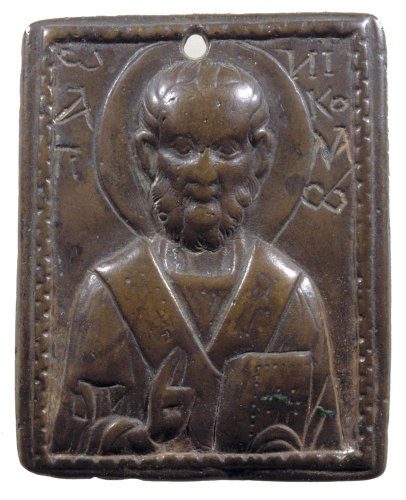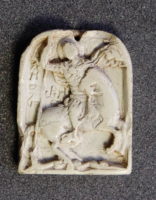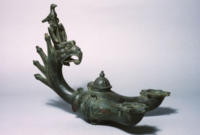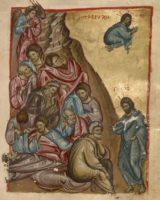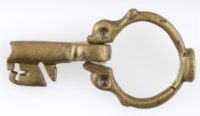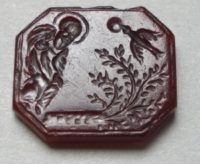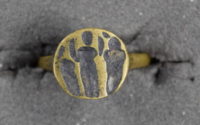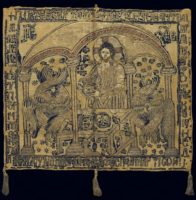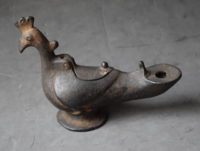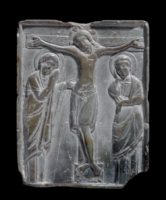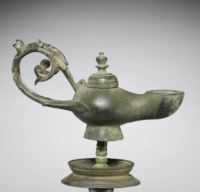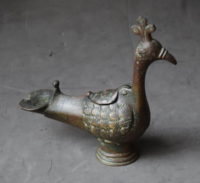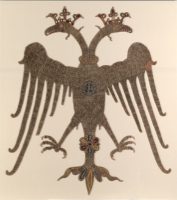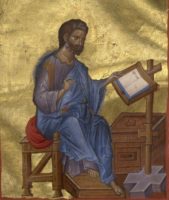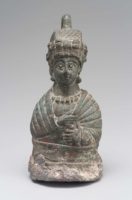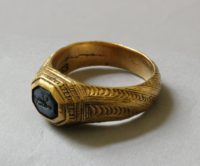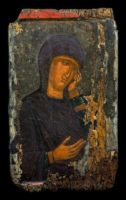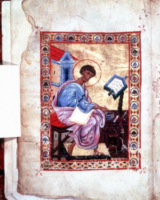Small icon of St Nicholas. Period: Late Byzantine; circa: First half of 13th century. Materials: bronze. The Benaki Museum of Greek Culture is housed in one of the most beautiful neoclassical-style buildings in Athens, near the National Garden and the Hellenic Parliament. It was converted into a museum in order to shelter the collections of Antonis Benakis and was donated to the Greek nation by himself and his three sisters, Alexandra, Penelope and Argine. Following its most recent refurbishment (1989–2000), the building houses a unique exhibition on Greek culture arranged diachronically from prehistory to the 20th century.
Seal, John Tarchaneiotes, Period: Late Byzantine, 13 th. century. (second half). St. John the Baptist standing, holding a staff cross over his left shoulder. The museum is open to the public Tuesday through Sunday, 11:30 a.m.–5:30 p.m., except for federal holidays.
Relief icon; Period: Late Byzantine, circa: 14-15th c. carved white steatite in the shape of half an oval; St George and the dragon with name inscribed. Length: 2 centimetres Width: 1.6 centimetres. British Museum is closed 24, 25 and 26 December and 1 January, but is open every other day of the year. Fast facts about the British Museum: Founded: 1753, Collection size: 8 million objects, Oldest object in the collection: Stone chopping tool (nearly 2 million years old).
Griffin’s Head Lamp, Period: Early Byzantine, circa 4th-5th century. Purchased from George Zacos (dealer), Istanbul by Dumbarton Oaks Research Library and Collection, Washington, DC, July 1962. The museum is open to the public Tuesday through Sunday, 11:30 a.m.–5:30 p.m., except for federal holidays.
The Agony in the Garden, Manuscript, Period: Late Byzantine; circa: 1200 to 1299 A.D. Place: Nicaea. (Modern Turkey) Material: Tempera colors and gold leaf on parchment bound between wood boards covered with light brown velvet. Dimensions: Leaf: 20.6 × 14.9 cm (8 1/8 × 5 7/8 in.)
Museum Description: “Placed within the Gospel of Matthew, the full-page miniature of the Agony in the Garden represents one of the more powerfully emotional moments in Jesus’ Passion. After the Passover meal, Jesus and his apostles retire to the Garden of Gethsemane, where Jesus foretells Saint Peter’s betrayal. Jesus then asks his closest disciples to stay awake with him, but later, while he prays, the apostles fall asleep.
The artist represents Jesus twice in the miniature: once confronting Peter at the bottom of the image and then praying above. Jesus’ feelings of isolation and abandonment as he prays are expressed visually by his physical separation not only from the apostles but also from the angel shown behind him. Against the hilly landscape, the apostles huddle together in their sleep, their bodies forming a mound almost as large as the mountain itself. The crisp folds of their garments are made of embedded geometric forms that echo the shape of the rocks at the top of the mountain.“
The J. Paul Getty Museum at the Getty Center in Los Angeles houses European paintings, drawings, sculpture, illuminated manuscripts, decorative arts, and photography from its beginnings to the present, gathered internationally.
Key, Materials: Bronze. Made in: Constantinople. Period: Early Byzantine (?). The Benaki Museum of Greek Culture is housed in one of the most beautiful neoclassical-style buildings in Athens, near the National Garden and the Hellenic Parliament.
Cross with Pearls, Period: Late Byzantine, circa: 1200–1400. Materials: Gold and pearls. On view at The Met Fifth Avenue in Gallery 303. The Metropolitan Museum of Art (New York) is one of the world’s largest and finest art museums. Its collection includes more than two million works of art spanning five thousand years of world culture, from prehistory to the present and from every part of the globe. Public Hours: 10:30 a.m.–5:30 p.m. Open seven days a week.
Octagonal intaglio, Period: Late Byzantine; circa: 14thc. Made in: Constantinople. Dimensions: Height: 1.7 centimetre. Material: sard. British Museum is closed 24, 25 and 26 December and 1 January, but is open every other day of the year. Fast facts about the British Museum: Founded: 1753, Collection size: 8 million objects, Oldest object in the collection: Stone chopping tool (nearly 2 million years old).
The Last Supper, Period: Late Byzantine; circa: 13th century, Place: Nicaea, Modern Turkey. (created) Dimensions: Leaf: 20.6 × 14.9 cm (8 1/8 × 5 7/8 in.).
The J. Paul Getty Museum at the Getty Center in Los Angeles houses European paintings, drawings, sculpture, illuminated manuscripts, decorative arts, and photography from its beginnings to the present, gathered internationally.
Bronze Signet Ring, Period: Early Byzantine, high circular bezel rudely engraved in intaglio with standing figure. Findspot: Smyrna, Anatolia. (Modern: Izmir, Turkey) British Museum is closed 24, 25 and 26 December and 1 January, but is open every other day of the year. Fast facts about the British Museum: Founded: 1753, Collection size: 8 million objects, Oldest object in the collection: Stone chopping tool (nearly 2 million years old).
Veil Embroidered with Gold Thread. Period: Late Byzantine; circa: end of the 13th or beginning of the 14th c. A liturgical article used for covering sacred vessels on an altar. It depicts Jesus in a portrayal of the Communion of the Apostles, symbolic of the sacrament of Holy Communion. One of the rare extant Byzantine embroideries. Made in: Constantinople. Dimensions: 0.52×0.65 m.
Hanging lamp; Period: Early Byzantine; (5thC-6thC). Found: Tell el-Yahudiya (Africa,Egypt,Lower Egypt,Nile Delta,Tell el-Yahudiya) Length: 6.24 inchesHeight: 4.75 inches. Material: Bronze. British Museum is closed 24, 25 and 26 December and 1 January, but is open every other day of the year. Fast facts about the British Museum: Founded: 1753, Collection size: 8 million objects, Oldest object in the collection: Stone chopping tool (nearly 2 million years old).
Relief plaque icon, depicting the Crucifixion with full-length figures of the Virgin on the left and St John on the right, Late Byzantine (13 thc). Materials: Steatite – Gold.
Lamp and Stand, Period: Early Byzantine, circa 400s. 34.8 x 13.5 cm (13 11/16 x 5 5/16 in.) Material: Bronze. The Cleveland Art Museum Hours: Tuesdays, Thursdays, Saturdays, Sundays 10:00 a.m.–5:00 p.m. Wednesdays, Fridays 10:00 a.m.–9:00 p.m. Closed Mondays.
Lamp for a Stand, Period: Early Byzantine. Material: Bronze. Found: Egypt. In the shape of a peacock, with circular foot; the spout is at the end of the tail, and the hole for filling in the back is covered by a hinged leaf-shaped lid.
British Museum is closed 24, 25 and 26 December and 1 January, but is open every other day of the year. Fast facts about the British Museum: Founded: 1753, Collection size: 8 million objects, Oldest object in the collection: Stone chopping tool (nearly 2 million years old).
Altar Cloth or Podea. Period: Late Byzantine, circa: late 14th century. Made in: probably Greece or Constantinople. Materials: Silk, embroidery. Dimensions: 58 1/2 x 51 1/8 in. (148.6 x 129.9 cm).
Museum Description: “The double-headed eagle became the primary symbol of the state during the late Byzantine centuries and was also adopted for liturgical use. This huge eagle was probably used as an altar cloth or as a podea, a skirt hung beneath an icon. The inscription, which connects the owner with distinguished imperial dynasties, exaggerated the claims of a pretender to the patriarchal throne.”
On view at The Met Fifth Avenue in Gallery 303. The Metropolitan Museum of Art (New York) is one of the world’s largest and finest art museums. Its collection includes more than two million works of art spanning five thousand years of world culture, from prehistory to the present and from every part of the globe. Public Hours: 10:30 a.m.–5:30 p.m. Open seven days a week.
Saint Mark. Period: Late Byzantine circa: late 13th century. Place: Constantinople (Place created) Dimensions: Leaf: 21 × 14.9 cm (8 1/4 × 5 7/8 in.). Museum Description: “Saint Mark pauses, quill in hand, as he writes his account of the life of Christ. This portrait of the saint as author introduces his Gospel in a Greek manuscript of the late 1200s. An inscription in red on the gold leaf background identifies the saint by name. ” The J. Paul Getty Museum at the Getty Center in Los Angeles houses European paintings, drawings, sculpture, illuminated manuscripts, decorative arts, and photography from its beginnings to the present, gathered internationally.
Steelyard weight in the form of a bust of an empress, Period: Early Byzantine Period, circa: 5th century A.D. Material: Bronze. The MFA is open 7 days a week. Monday and Tuesday 10 am–5 pm, Wednesday–Friday 10 am–10 pm, Saturday and Sunday 10 am–5 pm.
Gold Signet Ring, Period: Late Byzantine circa: 14thc. Made in: Constantinople. Diameter: 28 millimetres Weight: 375 grains. British Museum is closed 24, 25 and 26 December and 1 January, but is open every other day of the year. Fast facts about the British Museum: Founded: 1753, Collection size: 8 million objects, Oldest object in the collection: Stone chopping tool (nearly 2 million years old).
Icon of Depicting Virgin Mary Thornousa, which was probably part of a wider composition depicting Extreme Humiliation or Crucifixion. Period: Late Byzantine; circa: The fourth quarter of the 14th century. The shape of the Virgin Mary, with the scattered hair and the deformed by pain characteristics, refers to the expressive, anti-classical flow of Byzantine painting.
Gospels of Luke and John, Period:Middle Byzantine, circa: Late 12th-early 13th century A.D. The museum is open to the public Tuesday through Sunday, 11:30 a.m.–5:30 p.m., except for federal holidays.


